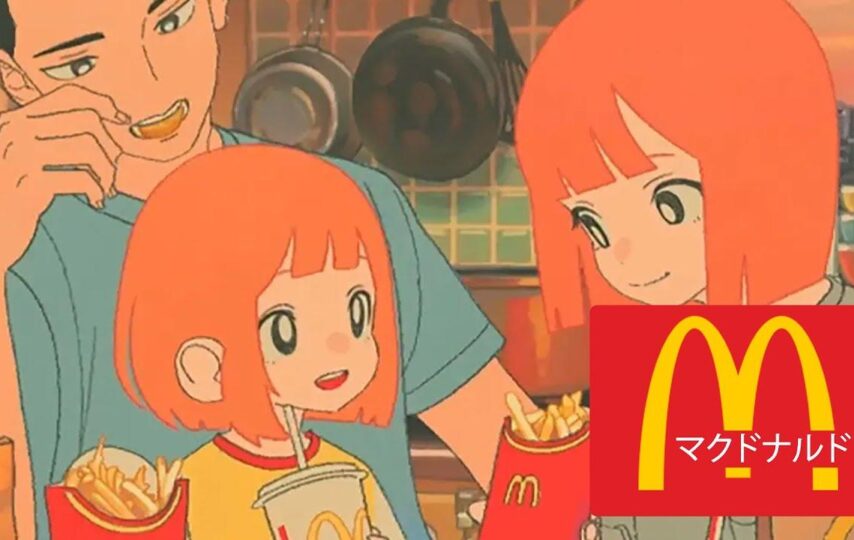The ability to influence extends beyond simple product promotion in the field of advertising. It may act as a mirror reflecting cultural norms, igniting conversations & even provoking controversy. A recent Japanese McDonald’s ad serves as one such instance; it has sparked a range of responses & in-depth discussions. We break down the layers of this advertisement in an interactive piece, looking at its family-oriented theme, animation style, reasons for the division, & larger cultural background.
How Does a Nostalgic Japanese McDonald’s Ad Spread Controversy on the Internet?
Image credit – B&T
Here’s are some briefly explained possibilities for the rise of the Japanese McDonald’s ad controversy:
Animation Style: A Heartwarming Touch
Ads’ aesthetic attractiveness often determines how interested viewers are in watching them. The animation style of this McDonald’s ad is a crucial component. Through the use of a charming & animated style, the advertisement immerses viewers in its fictional universe. This look is distinctly Japanese & reflects a national trend that is often seen in advertisements. The animation captivates viewers with its vivid colours, emotive figures, & smooth motions, evoking sentiments of cosiness & nostalgia.
Family Focus: Nostalgia and Wholesomeness
The storyline of the advertisement revolves on the image of a conventional nuclear family. The advertisement shows moments of bonding over a McDonald’s lunch as seen through the eyes of a mother, father, & daughter. This emphasis on family bonds touches on universal themes of love, community, & shared experiences, arousing feelings of nostalgia. Many viewers find emotional connection in the images of tenderness, laughing, & friendship, which evokes a sense of wholesomeness.
Reasons for the Divide: A Multifaceted Discourse
The ad has divided viewers despite its ostensibly innocent content, leading to differing interpretations & discussions.
Perfect Family Picture:
Some find solace & familiarity in the image of the conventional nuclear family. It upholds the highly valued principles of stability & unity by presenting an idealised picture of happy family life. Others, on the other hand, think that this portrayal is exclusive & ignores the variety of contemporary families’ circumstances. The focus on the nuclear family at a time when family structures are changing may be seen as ignoring the experiences of same-sex families, single-parent homes, & other non-traditional arrangements.
Apprehensions Regarding Fast Food Promotion:
The encouragement of fast food consumption, especially among kids, is another topic of debate. Critics contend that the advertisement normalises fast food consumption as a regular aspect of family life & praises poor eating habits. The representation of McDonald’s meals as a source of family happiness raises ethical problems regarding the responsibility of advertising in encouraging balanced lifestyles, particularly in light of the rising concerns about kid obesity & nutritional health.
“Propaganda” Charges:
On the other hand, some viewers have gone so far as to call the advertisement “pro-family propaganda.” They believe there is a covert purpose for the message & that it upholds traditional conservative societal norms & values. Concerns about manipulation & ideological impact arise when advertising is seen as a vehicle for forming cultural narratives, which leads to a closer examination of the motivations behind these kinds of campaigns.
The Broader Context: Social Dynamics & Cultural Variations
Image credit – NextShark
It’s crucial to place this advertisement in the larger cultural context of Japan in order to really appreciate its importance.
Japanese Traditional Values:
Japan is a traditional culture with strong cultural ties that values the family. Respect for filial piety & family ties penetrates many facets of everyday life, including media portrayal. This cultural focus on family unity & togetherness is reflected in the commercial’s representation of the typical nuclear family.
Rapid Cuisine Culture:
Although the consumption of fast food has increased recently in Japan, it still differs from the fast food culture that is common in several Western nations. The prevalence of international fast-food restaurants coexists with traditional Japanese cuisine, which places a strong emphasis on using fresh ingredients & skilled cooking. The McDonald’s advertisement depicting the restaurant as a source of happiness for families must be seen in the context of this culture, where occasional indulgence in sweets is counterbalanced by a more extensive culinary heritage.
Moving Through the Complexities: Understanding & Observations
Fundamentally, Japanese McDonald’s ads function as a microcosm of larger social discussions about advertising’s impact, family relationships, & health concerns.
Inclusivity & Representation:
The controversy around the idealised family picture serves as a reminder of how crucial diversity & representation are in media representations. Advertisers must take into account the variety of family experiences as societies change in order to make everyone feel appreciated & noticed.
Encouraging Well-Being Lifestyles:
The debate surrounding the advertising of fast food draws attention to the moral obligations of marketers in encouraging healthy living. In addition to being used to promote items, advertising has the power to influence social norms & behaviour. It’s a tricky but vital task to strike a balance between business interests & public health concerns.
Examining Advertising Methodologies:
The charge of “pro-family propaganda” prompts a critical examination of the purposes underlying marketing initiatives. Customers’ expanding media literacy has raised expectations for advertising strategies to be more genuine & transparent. Recognizing their ability to influence societal narratives, advertisers must walk a tightrope between persuasion & manipulation.
Frequently Asked Questions
Here are some frequently asked questions about Japanese McDonald’s ads:
1. Question: What is the main idea of the McDonald’s ad in Japanese?
- Answer: The main topic is on the uniting of families over McDonald’s food.
2. Question: How does the commercial’s animation style add to its impact?
- Answer: The endearing animation style arouses nostalgia & increases viewer involvement.
3. Question: What critics have been made of the commercial’s depiction of the typical nuclear family?
- Answer: Some claim that it ignores contemporary diversity & leaves out non-traditional family configurations.
4. Question: What issues have been brought up about the commercial’s promotion of fast food?
- Answer: A few viewers express concern that it could promote bad eating practices, especially among kids.
5. Question: How does the advertisement represent more general Japanese society values?
- Answer: It is a reflection of the persistent conflict between tradition & modernization as well as Japan’s more conventional attitudes on family formations.
Conclusion
When we peel back the layers of this Japanese McDonald’s ad, we find a complex web of social relationships, ethical issues, & cultural quirks. The advertisement functions as a prism through which to examine the topics of representation, health awareness, & the influence of advertising on cultural values.
It does this by showing family relationships & using a charming animation style. Through critical analysis & careful discussion, we may better understand the complex relationships that exist between media, society, & human behaviour.








